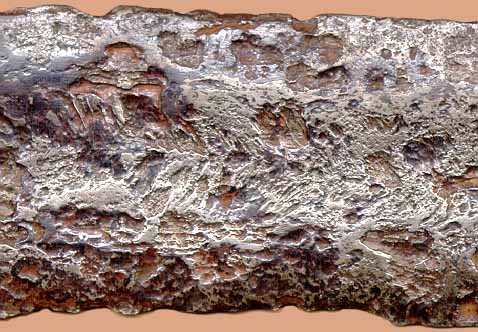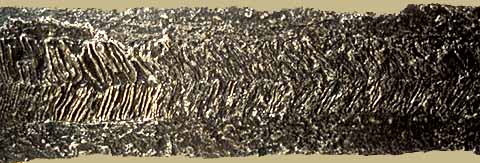

The pattern-welded structure of this blade has been well exposed by corrosion in this detail photograph from the more corroded side of the blade, opposite the inlay on the opposite, less corroded side. The broad shallow fuller corresponds to the patterned areas. The pattern consists of two bands of relatively straight pattern, that is, each originating from the exposed periphery of a twisted rod. As the pattern on each side of the midline of the face of the blade reflects that on the opposite, the twisted rods used to create the pattern had opposite directions of twist. (See also the section on pattern-welding).

This photograph from the mid-portion of the more corroded side of the blade discloses, especially on the right, non-patterned steel with a grain running lengthwise. The areas of patterning covering the fullers are thus disclosed to be only thin veneers of only about 1 to 2 mm. in thickness. From this it may be deduced that the rods which produced the pattern were greatly flattened either before they were applied to the core metal of the blade or were greatly flattened in the process of forging of the blade. No return of the twist is seen in the areas of erosion between the surface pattern and the core, suggesting that the bulk of the rods had been removed either before the sword was fabricated, or, less likely, from the fuller after fabrication. (The twist on opposite surfaces of the blade is in the wrong direction to support the central part of the blade having been formed of two twisted rods with plain cores mounted side by side similar to a single cored blade illustrated in Seitz (1981) fig. 66, p. 111.) The core in the present sword appears to be homogeneous in its exposed areas.

This illustration from a snapshot of a Viking Age sword in the Schweizerischen Landesmuseum in Zürich, Switzerland (LM 860) shows a blade with a very similar pattern, better exposed by corrosion. A brief description and illustration of this sword may be found in Schneider (1980), item 3, p. 15.